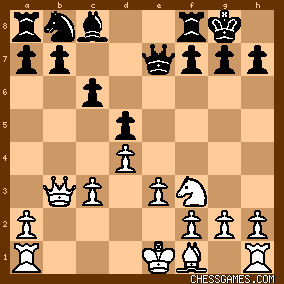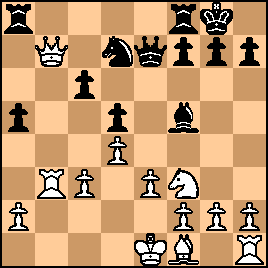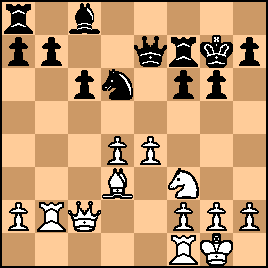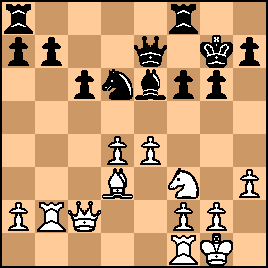| Nov-20-12 | | LUCHO RODRI: Lindo e instructivo final de torres y peones! |
|
| Jun-19-23 | | Gaito: In the book "Tarrasch's Best Games of Chess" (Selected and annotated by Fred Reinfeld) the opening moves are given in a different order, namely: 1.d4 d5 2.c4 e6 3.Nc3 Nf6 4.Bg5 Be7 5.Nf3 Ne4.
It would be interesting to find out what was the real order of moves in this game. I do not have a copy of Tarrasch's "Dreihundert Schachpartien: Ein Lehrbuch des Schachspiels für geübte Spiele". If this game is annotated in that book, then the real order of moves could be settled. |
|
| Jun-19-23 | | Gaito: 
click for larger viewWHITE TO PLAY
This simplifying variation of the QGD was fashionable at the beginning of the twentieth century. Some books call it "Lasker's variation". Capablanca played it often during his match with Marshall in 1909, with very good results. Black's idea is to exchange a few minor pieces and aim for an equal (though somewhat passive) position free of weaknesses and free of unnecessary complications. For those players who have an excellent endgame technique and who dislike complications this variation would be an excellent choice with the Black pieces. Good moves for White in this position are 7.Rc1; 7.cxd5 (as played in this game), and 7.e3. Stockfish 15.1 gives a numerical evaluation of +0.31 after 7.cxd5, and +0.35 after 7.Rc1. |
|
| Jun-19-23 | | Gaito: 
click for larger viewBLACK TO MOVE
In this equal position the theoretical recommendation ("book move") is of course 9...c6, as played in this game. Other moves that have been played are 9...Qd6!? and 9...Qd8 (also with approximate equality). But the engines recommend 9...c6 as the best move. The numerical evaluation of the engine (SF15.1) is +0.32. |
|
| Jun-19-23 | | Gaito: 
click for larger viewWHITE TO MOVE
11. Rb1!?
An original and interesting move. (Normal moves in this position are 11.Bd3, 11.a4, or even 11.Be2). In his annotations Fred Reinfeld gives an exclamation mark to the move 11.Rb1! and comments (quote): "Hampering the development of Black's Bishop -a difficulty which Alapin solves in a novel manner" (end of quote). |
|
| Jun-19-23 | | Gaito: 
click for larger viewBLACK TO PLAY
In this position Alapin played the safe 11...Nd7, with equality. An interesting game would have arisen after 11...Bf5!? 12.Qxb7 Nd7! 13.Rb3 a5! and Black would have good compensation for the sacrificed pawn (excellent piece play and a lead in development). (See diagram below):

click for larger view |
|
| Jun-19-23 | | Gaito: 
click for larger viewBLACK TO MOVE
13...Ne4?!
Reinfeld did not comment anything about this move, but the engine doesn't quite like it. Stockfish 15.1 suggests instead that Black play either 13...c5 or 13...b6, with approximate equality in either case. |
|
| Jun-19-23 | | Gaito: 
click for larger viewBLACK TO MOVE
15...g6
Reinfeld considers this move to be interesting and attaches the sign !? to it. On the other hand, the engines (Komodo 13 and Stockfish 15.1) consider that the move might perhaps be dubious (?!), and keep recommending either 15...b6 or 15...c5 with an equal game. Reinfeld's coment on 15...g6 is interesting: (quote): "A puzzling move, but its motivation is quite logical. Black wants to play ...f6 in order to prevent Ne5 and also in order to bring his King's Rook to f7, protecting his Queen's Knight Pawn (b7) and thus making possible the development of the Bishop. It will be interesting to study Tarrasch's procedure against this plan" (end of quote).
The numerical evaluation by the engine (SF 15.1) after the move 15...g6 is +0.79, but instead of 16.Rb2 (as played in the actual game) the engine suggests either 16.Bd3 or else 16.Qb2 with a minimal plus in White's favor. |
|
| Jun-19-23 | | Gaito: 
click for larger viewBLACK TO MOVE
After the move 20.e4! White already had a clear advantage (good control of the center and a lot of space on the Queen's wing). Black played 20...Rf8 (engine's evaluation: +1.50) and Reinfeld commented (quote) "An apparently pointless loss of time"
(end of quote).
The engine suggests 20...Be6 (evaluation: +1.37). The remainder of the game is a wonderful lesson by Dr. Tarrasch on how to play when you have a good central foothold and a clear advantage in space. Enjoy! |
|
| Jun-19-23 | | Gaito: 
click for larger viewWHITE TO MOVE
What would you play as White in this position? The engine (SF 15.1) recommends either 22.a4 or else 22.Re1 (overprotecting the e4 pawn). There is, however, another move, almost as good as the engine's recommendations and far more instructive: 22.Qb1! Reinfeld commented (quote): " Threatening to win at least a Pawn with e5". (end of quote). |
|
| Jun-19-23 | | Gaito: 
click for larger viewPROBLEM: WHITE TO MOVE AND WIN.
I guess that most players would play here 33.Rg1 in order to stop the mating threat on g2. But that move doesn't win. 33.Rg1? Qh5 34.Rg3 Bc8+ 35.Kg2 (see diagram)

click for larger view
35...Bxb7 36.Rxb7 Qxe5 37.Rh3+ Kg5 38.f4+ Qxf4 39.Rg3+, and Black can only prevent perpetual check by returning the queen for a rook, whereby the ensuing rook ending would be drawish. (diagram):

click for larger view |
|
| Jun-19-23 | | Gaito: 
click for larger viewWHITE TO MOVE
After 33.f4! White forced a favorable rook ending which he transformed into a victory with perfect technique. A very instructive and enjoyable game in all its phases! |
|





